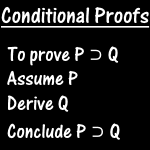Here we’re looking at the idea of nesting conditional proofs. This means to nest one assumption inside of another, closing off the scope of the inner assumption before we close off the scope of the outer assumption. We may nest as many conditional proofs as we like, though there are restrictions on what we can do with them. Something may be derived from a previous line in a proof only if that previous line is still part of an open scope. If it belongs to a conditional proof that has since been closed, it is no longer available. This is what keeps us from using conditional proof to prove anything at all. The whole point of conditional proof is prove a conditional by showing that a particular assumption would lead to a particular conclusion. What we can conclude from this is that if our assumption were true, then the conclusion following from it would be true. Nested conditional proofs will be illustrated with a proof of the rule of exportation. You can see this covered in the video, try to do the proof on your own, or just look at the answer below.
Prove the rule of Exportation without using it:
((P & Q) ⊃ R) ≡ (P ⊃ (Q ⊃ R))
For Next Time:
Prove the disjunctive forms of Commutation (P ∨ Q) ≡ (Q ∨ P) Association (P ∨ (Q ∨ R)) ≡ ((P ∨ Q) ∨ R)




Proving Distribution with Conditional Proof
[…] Association. In Rules of Inference for Biconditionals, we did proofs of Material Equivalence. In Nesting Conditional Proofs, we did a proof of Exportation. And in Proving Disjunctions with Conditional Proof, we did proofs […]